|
The Ubiquitous Swiss Army Knife (Includes: Victorinox Classic, Wenger Esquire, Victorinox Ambassador, Victorinox 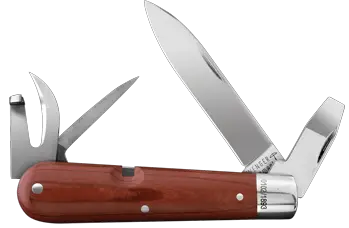 The Swiss Army adopted a folding, general purpose knife for issue to the troops in 1890. It was known as the Schweizer Offiziersmesser in German, which translates as "Swiss Officers Knife" in English. The first run of 15,000 knives (1890-1891) were manufactured by a company in Solingen, Germany, but from 1891 the Swiss Knife maker Karl Elsener (later the Company name was changed to Victorinox AG) took over production. The Model 1890 and all subsequent Swiss Soldier Knife models were multi-tools, as the Swiss Schmidt-Rubin Model 1889 infantry rifle required a screwdriver for assembly/disassembly and this, along with a knife blade, can opener and reamer were built into the Model 1890 folder. It happened that the Karl Elsener firm was located in the predominately German speaking part of Switzerland. Thus, in 1893 (apparently for political reasons) the firm Paul Boechat & Cie (later the Company name was changed to Wenger SA), located in the predominately French speaking part of Switzerland, also received a contract to manufacture Swiss Soldier Knives. Victorinox and Wenger split the Swiss Army knife contracts equally from 1908 until 2005, when Victorinox acquired Wenger. Although now a subsidiary of Victorinox, Wenger is operated as a separate company and still builds knives for the Swiss Army in their own factory, as does Victorinox. Therefore, there are two "real" brands of Swiss Soldier Knife, Victorinox and Wenger. There are also countless lower quality knock-offs made in third world countries around the globe, but these inferior knives will not be addressed in this article. At the end of the Second World War, thousands of (non-German speaking) American GI's in Europe purchased Schweizer Offiziersmesser knives and began calling them "Swiss Army Knives." The name stuck and that is how they are known in the United States to this day. Both Victorinox and Wenger have long produced numerous civilian/sports knife models never adopted by the Swiss Army, although they are part of the Companies' extensive Swiss Army Knife collections. It was Karl Elsener who, early on, began marking his Soldier Knives with a Swiss cross on shield. Incidentally, the Victorinox and Wenger cross logos differ in shape and color. The typical Victorinox cross is silver and outlined by a silver shield shape with concave sides, while the typical Wenger cross is white and surrounded by a white square with convex sides. Another long standing distinction (apparently the result of a simple gentleman's agreement) is that Victorinox knives are advertised as the "Original Swiss Army Knife," while Wenger knives are the "Genuine Swiss Army Knife." Over the years, the Swiss Army knife has been revised and improved. For instance, stainless steel blades were introduced in 1921. Five basic models: 1890, 1908, 1951, 1961 and 08 have been officially adopted by the Swiss Army. The most recent of these is the Model 08 (2008), first issued in 2009. The scale (handle) material, originally wood, has changed over the years. Swiss Army sport (civilian) knife handle shells have been made of many materials and in a variety of colors. Aluminum (alox) remains popular and was used in the Swiss Army Model 1961, issued between 1961 and 2008. The current Swiss Army Model 08 has olive green nylon grips with non-slip inlays. However, the most familiar and identifiable handle material to most civilians is red plastic, which is widely used by both Victorinox and Wenger. Victorinox uses a plastic called "Cellidor," which is supplied by ALBIS Plastic GMBH of Hamburg, Germany. As far as I can tell, Wenger doesn't specify the plastic used in their handles, but it looks the same. Modern Swiss Army knife blades and tools are fabricated from stainless steel, which is hardened for optimum performance of their various individual functions. For instance, knife blades are reportedly hardened to 56 HRC and most tools are hardened to 49-53 HRC, depending on intended purpose. The separators between the blades are aluminum and the rivets and bushings used to assemble the knives are made of brass. Swiss Army Knives are assembled by hand. They are precision tools, as evidenced by the tightness of their blades; there is no wobble or play in a Swiss Army knife blade. The blades and tools carry a lifetime warranty against defects in material and workmanship. Most of the Swiss Army models have knife blades fabricated from rather thin stock. They are sharpened evenly on both sides at a laser verified 15-degree angle. When shipped from the factory, Swiss Army Knives are sharp and the edge is easily maintained. I use a fine Arkansas stone on all of my Swiss Army Knives to touch up the edge, while avoiding undue blade wear. The typical blade shape uses a drop point with a relatively long, straight cutting edge that curves gently to a nearly symmetrical, spade shaped, point at approximately the mid-blade level. Wenger calls this a "spear blade." It is a utility shape, not a fighting blade. Victorinox builds Swiss Army knives 58mm, 74mm, 84mm, 91mm, 100mm, 108mm and 111mm in length. Wenger offers Swiss Army knives of 65mm, 75mm, 85mm, 93mm, 100mm and 120mm in length. The thickness, of course, depends on how many layers (bays) of tools are incorporated. Perhaps the most common tools include the knife blade, tweezers, toothpick, nail file, screwdriver, Phillips screwdriver, bottle opener, can opener, reamer, scissors and corkscrew. The tools I use most are the knife blade, scissors, tweezers, toothpick, file and flat tip screwdriver. As practically everyone knows, there are a plethora of Swiss Army knife models. Victorinox and Wenger each offer dozens of individual knife models in a rainbow of colors and with various handle materials. There are far too many variations to review for an article of this size. The Swiss Army knives examined for this review include, from smallest to largest, the Victorinox Classic SD (#53001), Wenger Esquire (#16940), Victorinox Ambassador (#53681), Victorinox Tinker Small (#53133), Wenger EvoGrip S18 (#16802), Victorinox Climber (#53381) and Victorinox Sentinal Clip #54882). The S18 and Sentinal are lock-blade models, all of the others rely on spring tension to keep their blades open. Acquiring the knives for this article was simple, as I own them. In some cases the measurements given below vary slightly from the manufacturer's specification, because I measured the knives with a digital caliper and used those figures. Victorinox Classic SD  My oldest Swiss Army knife, a little Victorinox Classic, was given to me by my parents after they returned from a trip to Switzerland. That was in 1967 or 1968 and I was in the USAF. I was a radar repair technician at the time and I used it as my "seven level" screwdriver, eschewing my Air Force issue tools. The Classic is part of the Victorinox Everyday category of knives and I certainly used mine everyday. Although the red anodizing has completely worn off of its aluminum side plates, it is still in service. One leaf broke off of its scissors V-spring long ago, but the scissors still work with only half a spring. (Current scissors springs have been improved, as this was once a common failure.) My subsequent Classic SD knives have had the more modern Cellidor (plastic) handles. I have owned a number of these useful little knives and there is one on my motorcycle key ring as I write these words. (A small split ring is included with each knife for this purpose.) Another handy place to keep a Classic is in your travel or shaving kit. Ditto the bathroom drawer where you keep scissors, tweezers, razor and so forth. There is practically no end to the usefulness of these little multi-tool knives. Part of the reason I have owned several Classic SD's is that I have given a few of mine to friends who lacked a pocket knife. Women, in particular, seldom seem to have a pocket knife when required and a Classic fills the need. The Classic knife blade is 1-9/16" long and seems to have a little more spring tension keeping it open than the Wenger Esquire model (see below), which makes the Classic blade a little less likely to accidentally fold when in use. The Classic's little scissors, toothpick, tweezers, nail file, screwdriver tip and small knife blade are all entirely functional and very useful to have available on your person. This probably explains why it has been a best seller for decades. It is amazing how often these tools get used, particularly the scissors for snipping off dangling threads, hair, fingernails, etc. in addition to cutting paper. The tweezers work well for removing splinters in the field. The nail file can be used to de-burr all sorts of things in addition to fingernails, but don't torque too hard on a stuck screw with its screwdriver tip or you could snap the thin blade. The Classic is such a small and handy little knife that I suggest you don't leave home without one. Classic SD Specifications
Wenger Esquire 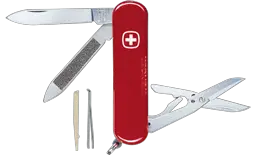 This is Wenger's smallest Swiss Army knife, �" longer than the Victorinox Classic and slightly wider, but no heavier. It is also suitable for key ring use and all of the other purposes mentioned above for the Victorinox Classic, with which it primarily competes. My Esquire resides on the ring with my car keys. The Wenger scissors boast a "springless, serrated, self-sharpening design," no doubt in response to the spring breakage issue mentioned in the Classic section. The Esquire scissors are noticeably larger than the Classic SD scissors, which makes them more versatile. The Esquire knife blade also benefits from the platform's extra length, measuring 1-13/16", a full �" longer than the Classic blade. Another difference between the two brands is that the Wenger tweezers and toothpick are fingernail accessible from inside the end of the red plastic handles, rather than having external fingernail nubs. This should make them less prone to loss. Interestingly, the Esquire nail file is larger than the files in the Victorinox Classic and Ambassador models, which is good. However, I find the pointed nail cleaner tip on the Esquire nail file less useful than the flat screwdriver tip on the Classic nail file. The Esquire's pointed tip can be ground flat to serve as a light duty screwdriver and I have done this. However, if you modify the tip of the file to serve as a screwdriver, remember that (like the Classic file/screwdriver) it can't handle a lot of torque. Overall, compared to the Victorinox Classic, the Esquire benefits from its �" extra length and, as long as the slight extra bulk is not a problem in your specific application, the Esquire is probably more versatile. It is just large enough not to get lost in a front pants pocket, should you choose to carry it that way. It falls between the Victorinox Classic and Ambassador models in size and application. Esquire Specifications
Victorinox Ambassador 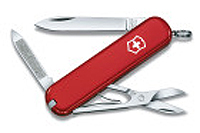 Part of the Victorinox Everyday category, the Ambassador is one of the best selling Victorinox models. It is my favorite Swiss Army Knife for actual pocket carry. Because it is a single bay knife, essentially a larger version of the Classic design, it is flat and unobtrusive in a front pants pocket. Its 3" overall length is an ideal size for a general purpose pocket knife. The only improvement I would wish for is a locking knife blade. The Ambassadors knife blade measures 2-1/16" long and has a 1-7/8" cutting edge. Made from relatively thin stock and factory ground with a 30-degree cutting edge, the blade holds an edge reasonably well, more than sufficient for a utility pocket knife, although not as long under hard use as knives made from harder steel, such as a Buck. On the other hand, like all Swiss Army knives, the Ambassador is easy to sharpen and it will take a fine edge. The scissors are an excellent size, small enough for fine work and large enough to make cutting an article from a magazine faster and easier than with the little Classic's scissors. There is no direct equivalent to the Ambassador in the Wenger line. Their smaller Wenger Esquire (see above) must compete with both the Classic and Ambassador. Ambassador Specifications
Victorinox Tinker Small 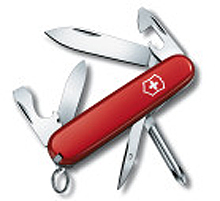 The Tinker Small is only �" longer than the Ambassador, but it is considerably thicker across its handles, with an extra separator and (therefore) two bays of tools. This makes it noticeably wider when carried in a front pants pocket. The main knife blade is 2-1/2" long with a 2-1/8" cutting edge. The small blade is 1-9/16" long with a 1-7/16" cutting edge. Both are the typical Swiss Army Knife drop point shape. As you can see from the list of tools in the specifications below, the Tinker Small has a lot of functions (12) for a two bay knife. Had I chosen the tool set for the Tinker Small, I would have replaced the small knife blade with a nail file, my feeling being that one cutting blade is sufficient and the larger blade isn't really that long, anyway. Interestingly, the otherwise nearly identical Wenger Highlander (#16979), also 3.25" long and 1.9 ounces in weight, does incorporate a nail file instead of a second cutting blade. The Wenger direct equivalent is the Teton (#16984), which is the same size, shape, weight and incorporates the same tools as the Tinker Small. The Victorinox line boasts three Tinker models. Tinker Small is a 3-1/4" long, two bay design. The standard Tinker offers the same selection of tools on a longer 3-1/2" chassis. Both are two bay knives and, you will note, lack scissors. The three bay Super Tinker shares the same length as the standard Tinker, but incorporates scissors. All three Tinkers are part of the large Victorinox Outdoor category. Tinker Small Specifications
Wenger EvoGrip S18 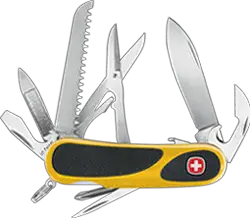 The versatile EvoGrip S18 features a locking knife blade. It is a four bay design with 11 implements that perform 14 functions. Two of the S18's implements, the wood saw and the scissors, each have a bay to themselves. The bottle opener and can opener share a bay and the knife blade and nail file share the fourth bay. For those who don't need the double cut wood saw blade, Wenger offers the otherwise identical EvoGrip S16, which is one bay thinner and a half ounce lighter. The handles of both are yellow plastic. As its name implies, the EvoGrip is more ergonomic than a traditional Swiss Army Knife. Wenger introduced their first ergonomic Swiss Army Knife in 2005 and the EvoGrip line expands on this theme by adding non-slip panels. I don't find the EvoGrip grip markedly superior to the smooth oval shape of traditional Swiss Army knives, but some might. Certainly, the EvoGrip shape is not a hinderance and it looks nice. The S18 actually measures 3.35" in length, slightly longer than the 3-1/4" (3.25") claimed. It features a locking, 2-1/2" knife blade with a 2-1/8" cutting edge. The lock release is near the blade pivot (the little lever visible at the base of the blade in the photo above) and operated by pressing down with the thumb of the hand holding the knife. To prevent the blade snapping closed and possibly cutting the operator's thumb, there is a positive mid-position "stop" notch, which allows to user to move his/her thumb to safety before pressing the blade the rest of the way closed. This is a typical Wenger Swiss Army Knife spear blade shape. There is no small knife blade. Wenger provides a more useful nail file in place of a small knife blade. I very much appreciate the S18's locking main blade, which I regard as an important safety feature. This feature, in addition to its excellent tool set, makes the S18 one of my favorite Swiss Army Knives. The S18 is especially popular with campers and outdoorsmen. Its bright yellow handle makes it relatively easy to find if dropped outdoors. I find it too bulky for pants pocket carry, but it rides comfortably in most jacket pockets. The S18 can be conveniently carried in a hunting vest, fishing vest, back pack, purse, briefcase, or fanny pack (I use the latter) and it doesn't occupy an excessive amount of space. In the Victorinox line, the Outrider (#54731) offers a similar set of implements, incorporates a locking main blade and retails for a similar price. However, it is a considerably larger multi-tool, over an inch longer at 4.4", 1.25" wide and weighs 4.8 ounces. EvoGrip S18 Specifications
Victorinox Climber 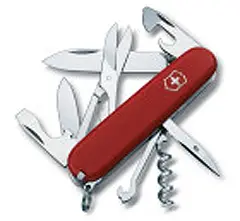 The Climber is a three bay design, which allows a total of some 14 implements. There are several three bay Swiss Army Knives from both Victorinox and Wenger and these are probably what most people think of as "typical" Swiss Army Knives. Victorinox describes the Climber as "designed for outdoorsmen who want to carry it all without the bulk." At 3-1/2" long and almost �" wide it is not tiny, but it is not a monster. The main knife blade is a useful 2-11/16" long with a 2-3/8" cutting edge. The small blade is 1-5/8" long with a 1-1/2" cutting edge. Both are the typical Swiss Army Knife drop point shape. Since the Climber is an Outdoor category knife and I am an outdoor writer, I must observe that I would happily sacrifice the small blade in favor of a liner lock to keep the main blade from closing over your fingers if you hit bone. On the other hand, not being much of a wine drinker, I would not miss the cork screw if it were eliminated, particularly since it increases the bulk of the knife. The Climber fits easily into a hunting vest, fishing vest, purse, fanny pack or back pack. It seems a little large for pants pocket carry, but it fits comfortably in most jacket pockets and is easily stashed in most ladies' purses. Overall, the Climber is a compact and versatile multi-tool. In the Wenger line the 3-1/4" long, 2.6 ounce Traveler (#16932) fills the same basic role and offers almost the same tools. The Wenger Traveler substitutes a nail file for the Climber's small cutting blade (good), deletes the parcel carrier hook (no real loss) and provides a patented lock for the screwdriver/bottle opener tool. Climber Specifications
Victorinox Sentinal Clip 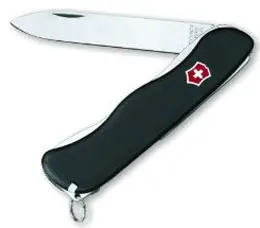 The Sentinal Clip is one of the longest Victorinox Swiss Army knives and one of the simplest, with a single bay and a single blade. There is an integral clip on one side of the handle, the usual slide-out toothpick and tweezers buried in the end of the handle and a key ring inox. The latter seems rather pointless, as this would be a very big knife to hang on a key ring. The knife blade is held open by means of a liner lock, the tab of which is pressed inward to release the blade for folding. Because the operator's thumb is in the path of the blade when pressing the liner lock release, Victorinox incorporated a mid-position "stop" notch, which allows to user to move his/her thumb to safety before pressing the blade the rest of the way closed. The Sentinal Clip reviewed here (# 54882) is easily opened with two hands, much like the popular Buck Folding Hunter, which is perhaps the best known of all lock blade folders. There is also a One Hand Sentinal Clip (#54885) with a Spyderco-like hole in the blade to allow one hand opening. The two Sentinal Clip models are otherwise identical. In addition to the Sentinal Clip models, there are identical Sentinals without the external pocket/waistband clip. The clip-less Sentinals are only 0.48" thick. The Sentinal is only about 1/2" shorter than a Buck Folding Hunter and, at 3-3/8" long with a 3-1/8" cutting edge, its blade is only about 1/4" shorter than the big Buck's. However, the Sentinal is considerably thinner and lighter than a Buck Folding Hunter, which makes it much nicer for daily carry. Unlike the Buck's heavy duty clip point blade, the Sentinal's blade is made from thinner stock and it is the typical Swiss Army Knife drop point shape. Like all Swiss Army Knives with which I am familiar, it is a utility blade. You can clip a Sentinal to your pants pocket to keep it in place, or to the inside of your waistband. I prefer the latter method, which lets me forget the knife is even there, until I need it. The thin Sentinal's light weight is a big plus for inside the waistband carry. In the Wenger line, the 5.1" long, 3.2 ounce Ranger 51 with clip (#16317) fills the same basic role, although it is somewhat larger in all dimensions. It offers a 3.9" single lock blade of similar utility shape as the Sentinal. Sentinal Clip Specifications
|